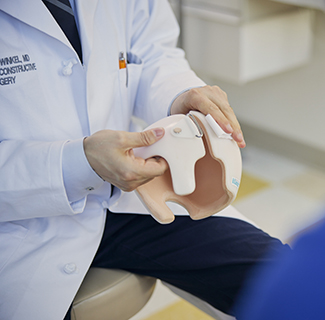Craniosynostosis Diagnosis and Treatment
Early diagnosis and treatment of craniosynostosis is vital to help your child meet developmental milestones. The most common treatment is surgery to modify the shape of the head and allow for brain growth. We offer:
- Oregon’s largest and most experienced center for treating craniofacial disorders. We can rapidly develop the best possible treatment and follow-up plan for your child.
- Providers who are among the best nationwide for the treatment of craniosynostosis.
- Specialists in neuropsychology, who monitor and treat developmental delays.
- Ongoing care, including annual checkups for six years or longer, based on your child’s needs.
Diagnosing craniosynostosis
If your child’s head shape seems unusual, it could be a sign that the soft spaces between sections of the skull are not developing properly. This condition is called craniosynostosis. It happens when the elastic areas of the skull that give the brain room to grow close too early.
If your child’s provider suspects craniosynostosis, they may refer you to OHSU. Our experts use screening tests to look for signs of this condition. A screening may include:
- A dilated eye exam, to look for vision problems.
- A developmental exam, to look for early signs of other disorders that affect the central nervous system. We may also recommend genetic testing to understand your child’s risk of inherited conditions.
- A physical exam, to feel your baby's head for signs of ridges in the skull and look for unusual facial features.
- Imaging studies, such as an X-ray or a computerized tomography (CT) scan, to make detailed pictures of how your baby's skull is developing.
- A neuropsychological exam, where a specialist will look for signs of problems in your child’s brain and nervous system.
Treatments for craniosynostosis
Surgery
If your child is diagnosed with craniosynostosis in the first few weeks of life, OHSU offers several surgery options to reshape the skull. We will work with you to create the right plan for your baby, based on the type and severity of their condition.
Minimally invasive endoscopic surgery: We use this surgery for single-suture craniosynostosis in children less than 3 or 4 months old. Our surgeon uses a fiber-optic tool and tiny incisions to operate on the skull. After surgery, your baby will likely use a helmet for up to 12 months to help their head keep its new shape.
Cranial vault remodeling (CVR): We use this surgery in children 6 to 12 months old. This is a traditional or open surgery. We remove the affected suture and rebuild the skull to allow the brain to grow. Most children will not use a helmet after this surgery.
Cranial vault distraction osteogenesis (CVDO): We may recommend this surgery for children with more than one suture affected by craniosynostosis. This is a traditional or open surgery. We carefully separate the skull bones and place devices to slowly stretch the bone and skin. This allows the brain to grow.
Depending on the surgery, your child will spend up to three nights in the hospital. Your care team will make sure your child is comfortable and behaving normally before they go home.
Helmet therapy

After endoscopic surgery and cranial vault remodeling, your child will need a series of helmets to continue shaping their skull.
Some children may need helmet therapy after open surgery.
Follow-up care
In most cases, children with craniosynostosis do not need follow-up surgery. After your child’s surgery you will meet with your child’s brain surgeon, plastic surgeon, and pediatric nurse practitioner for follow-up care. Our team will also conduct tests to check how your child’s brain functions.
Our team will meet with your child each year until age 6 to monitor their development.
Additional services for craniosynostosis
OHSU’s complete care for craniofacial disorders includes emotional support for your family. Our team has a pediatric psychologist from OHSU’s Child Development Rehabilitation Center who will work with your family and connect you to community resources.
Doernbecher’s Child Life program also offers play-based education and activities for your child and their siblings, to help them prepare for and cope with surgery.
Learn more
- Primary Craniosynostosis, National Organization for Rare Disorders (NORD)
- Craniosynostosis Questions and Answers, Craniosynostosis and Positional Plagiocephaly Support (CAPPS)
- The 7 Things You Should Know Before Your Child’s Surgery, Children’s Craniofacial Association
Location
OHSU Doernbecher Children’s Hospital
700 S.W. Campus Drive
Portland, OR 97239
Free parking for patients and visitors
For referring providers
Refer your patient to OHSU Doernbecher.
Call 503-494-8088 to:
- Seek provider-to-provider advice.
- Request education about plagiocephaly or other conditions.